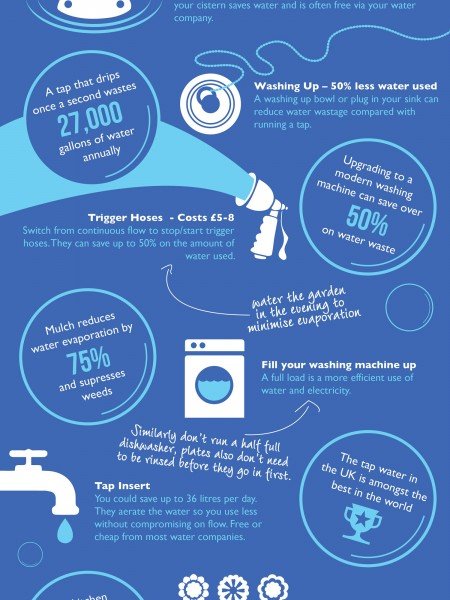● Use a bowl in the sink when washing fruit, vegetables of dishes.
You can then use the same water to water plants to save water.
● Fill a jug of water and put it in the fridge for when you want a cold
drink.
● Turn off the tap when you clean your teeth. A running tap uses up
to nine liters of water a minute.
● Wait until you have a full load before using your washing machine
or your dishwasher. Some new washing machines use less than
seven liters of water for each kilogram of clothes, while modern
dishwashers can us as little as 10 to 15 liters of water a cycle.
● If possible, take a shower instead of a bath. A five-minute shower
uses about 40 liters of water. This is about half the volume of a
standard bath.
● Use a water-saving device in your toilet cistern. Depending on the
size of your cistern, you could save between one and three litres
each time you flush the toilet.
● Practically everything you buy, use and consume has a water
footprint because it took water to process and transport it. Being
thoughtful about purchases, reusing where you can and recycling
can reduce your water footprint.
● Conservation of water can also extend the life of your septic system by
reducing soil saturation and reducing pollution due to leaks.
Overloading municipal sewer systems can also cause untreated
sewage to flow to lakes and rivers.
● Try a water-saving shower head and fix aerators to your taps, a
great and cheap way to save water and money. Limiting shower
times to four minutes—the length of a good song—also helps.
● Keep a bottle of tap water in the fridge for drinking. This way you
don’t need to run the tap in summer until it gets cold enough for
drink.
● For older toilets without water saving features (like a dual flush), try
taking up some of the space in your cistern by adding in a brick or
some pebbles. This will decrease the volume of water used with
each flush.
● Only use your dishwasher and washing machine with full loads to
optimize water usage, or change the settings to suit the load.
● Install a water tank. In many locations, installing a water tank to
collect roof run off is an easy and practical way of gathering
rainwater for use in the home or garden.
● Older flush use 3 to 4 times more water as compared to the new
ones. Convert your old flush toilet to a dual-flush toilet. A dual-flush
toilet allows you to use less water to flush liquid waste and more
water to flush solid waste simply by pressing the correct button.
● Scrape dishes instead of rinsing them under running water before
loading your dishwasher. For heavy cleaning of grills or oven parts
pre-soak them overnight.
● When washing dishes by hand, do not wash or rinse with running
water. Use tubs or plug the sink.
● Capture excess water in a container while running the tap. This
water can be used for your plants, pets or cleaning.
● Dishwashers use large volumes of water, about 60 liters of water
per load. Operate automatic dishwashers at full capacity and/or set
the water level for the size of your load.
● Give your houseplants some extra nourishment by recycling the
water you use to wash your fruits, rice, dal etc.
● Measure and use the exact water quantity while boiling rice or
pasta to avoid wastage.
● Do not throw away the excess water after boiling vegetables or
chicken. Store the stock and use it later to make curries and
delicious soup.
Tags: Water saving tips, Water efficiency, Water, Water conservation, save water, water saving, economize water

